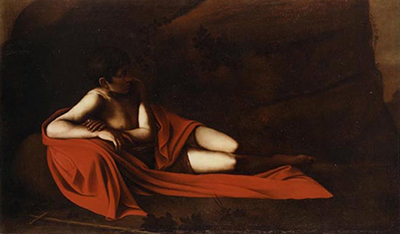Reclining Baptist is considered as the last painting by Caravaggio and does not possess many similarities to his artistic works.
After his death, this painting received many disputes and some scholars dismissed it as one of Caravaggio’s work. The painting is now preserved in Munich, under private observation after it was discovered in Argentina.
The painting possesses a symbolic style used by many painters at the time and notably by Caravaggio by using a medium of canvas and oil.
These kinds of paintings signified the prowess of a painter at the time owing to the fact that it was hard to give detail to an oil paint which was done on a rough platform like a canvas.
Although the painters at the time drew for the passion of it as the paintings were not very marketable, Caravaggio was privileged to have a cardinal friend who encouraged and supported him in his work by introducing him to some religious leaders. His paintings were greatly inspired by religious leaders and characters in the bible which he put down in painting.
There are various reasons that made the painting be credited to Caravaggio. The bishop of Caserta wrote to Cardinal Scipione in July 1610 after Caravaggio’s death that there had discovered three paintings in the Naples which most likely belonged to him.
These paintings were meant to be Scorpion’s, who was a close friend and contributor to Caravaggio’s work before his death. Scipione had directed the Marchesa to take care of the paintings which were in his custody but they were later taken away in Naples by Malta’s head of the Knights.
The head of Malta claimed that the paintings were seized since Caravaggio was a Knight of the Order, which meant that all his possessions belonged to the Knights. These claims were known to be untrue as Caravaggio had since been expelled from the Order from as early as in 1608.
A Viceroy of Naples who had arrived in Spain heard about the conflict of ownership of the painting and wrote to the Spanish head telling him that the paintings had no right being in their possession and should be sent back to the Viceroy. The three paintings disappeared later on, although there are some claims that the Viceroy may have secured them and sent them to Spain.




